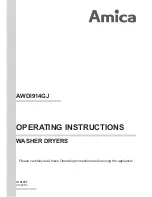
20
2. STEP: PREPARING THE LAUNDRY
350077
1.
Sort the laundry by type and thickness of the fabric (see Program Table).
2.
Close the buttons and zips, tie any ribbons, and turn the pockets inside out.
3.
Place very sensitive clothes in a special-purpose laundry washing bag.
The following types of laundry may not be dried in the dryer
as this may cause your garments to deform:
•
leather garments and other leather products;
•
garments that are waxed or treated in any other way;
•
garments with major wooden, plastic, or metal parts;
•
garments with spangles;
•
garments with metal parts subject to rusting.
The final part of a tumble dryer cycle occurs without heat
(cool down cycle) to ensure that the items are left at a
temperature that ensures that the items will not be damaged.
Remove all objects from pockets such as lighters and matches.
Oil-affected items can ignite spontaneously, especially when
exposed to heat sources such as in a tumble dryer. The
items become warm, causing an oxidation reaction in the oil.
Oxidation creates heat. If the heat cannot escape, the items
can become hot enough to catch fire. Piling, stacking or
storing oil-affected items can prevent heat from escaping and
so create a fire hazard.
If it is unavoidable that fabrics that contain vegetable or
cooking oil or have been contaminated by hair care products
be placed in a tumble dryer they should first be washed in hot
water with extra detergent - this will reduce, but not eliminate,
the hazard
















































